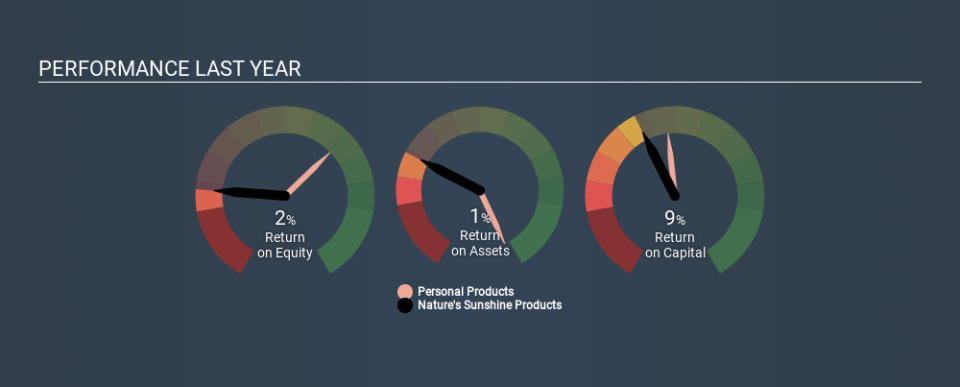Why We’re Not Impressed By Nature's Sunshine Products, Inc.’s (NASDAQ:NATR) 8.8% ROCE

Today we'll look at Nature's Sunshine Products, Inc. (NASDAQ:NATR) and reflect on its potential as an investment. Specifically, we're going to calculate its Return On Capital Employed (ROCE), in the hopes of getting some insight into the business.
First of all, we'll work out how to calculate ROCE. Next, we'll compare it to others in its industry. Finally, we'll look at how its current liabilities affect its ROCE.
Return On Capital Employed (ROCE): What is it?
ROCE measures the 'return' (pre-tax profit) a company generates from capital employed in its business. In general, businesses with a higher ROCE are usually better quality. Ultimately, it is a useful but imperfect metric. Author Edwin Whiting says to be careful when comparing the ROCE of different businesses, since 'No two businesses are exactly alike.
So, How Do We Calculate ROCE?
The formula for calculating the return on capital employed is:
Return on Capital Employed = Earnings Before Interest and Tax (EBIT) ÷ (Total Assets - Current Liabilities)
Or for Nature's Sunshine Products:
0.088 = US$13m ÷ (US$215m - US$62m) (Based on the trailing twelve months to September 2019.)
So, Nature's Sunshine Products has an ROCE of 8.8%.
View our latest analysis for Nature's Sunshine Products
Is Nature's Sunshine Products's ROCE Good?
When making comparisons between similar businesses, investors may find ROCE useful. In this analysis, Nature's Sunshine Products's ROCE appears meaningfully below the 23% average reported by the Personal Products industry. This could be seen as a negative, as it suggests some competitors may be employing their capital more efficiently. Separate from how Nature's Sunshine Products stacks up against its industry, its ROCE in absolute terms is mediocre; relative to the returns on government bonds. Readers may find more attractive investment prospects elsewhere.
You can click on the image below to see (in greater detail) how Nature's Sunshine Products's past growth compares to other companies.
When considering ROCE, bear in mind that it reflects the past and does not necessarily predict the future. Companies in cyclical industries can be difficult to understand using ROCE, as returns typically look high during boom times, and low during busts. This is because ROCE only looks at one year, instead of considering returns across a whole cycle. If Nature's Sunshine Products is cyclical, it could make sense to check out this free graph of past earnings, revenue and cash flow.
What Are Current Liabilities, And How Do They Affect Nature's Sunshine Products's ROCE?
Current liabilities include invoices, such as supplier payments, short-term debt, or a tax bill, that need to be paid within 12 months. Due to the way ROCE is calculated, a high level of current liabilities makes a company look as though it has less capital employed, and thus can (sometimes unfairly) boost the ROCE. To counteract this, we check if a company has high current liabilities, relative to its total assets.
Nature's Sunshine Products has current liabilities of US$62m and total assets of US$215m. As a result, its current liabilities are equal to approximately 29% of its total assets. This is a modest level of current liabilities, which would only have a small effect on ROCE.
What We Can Learn From Nature's Sunshine Products's ROCE
That said, Nature's Sunshine Products's ROCE is mediocre, there may be more attractive investments around. Of course, you might also be able to find a better stock than Nature's Sunshine Products. So you may wish to see this free collection of other companies that have grown earnings strongly.
If you are like me, then you will not want to miss this free list of growing companies that insiders are buying.
If you spot an error that warrants correction, please contact the editor at editorial-team@simplywallst.com. This article by Simply Wall St is general in nature. It does not constitute a recommendation to buy or sell any stock, and does not take account of your objectives, or your financial situation. Simply Wall St has no position in the stocks mentioned.
We aim to bring you long-term focused research analysis driven by fundamental data. Note that our analysis may not factor in the latest price-sensitive company announcements or qualitative material. Thank you for reading.


